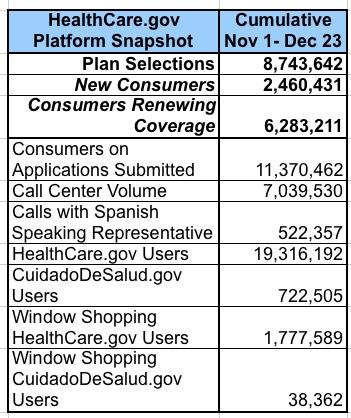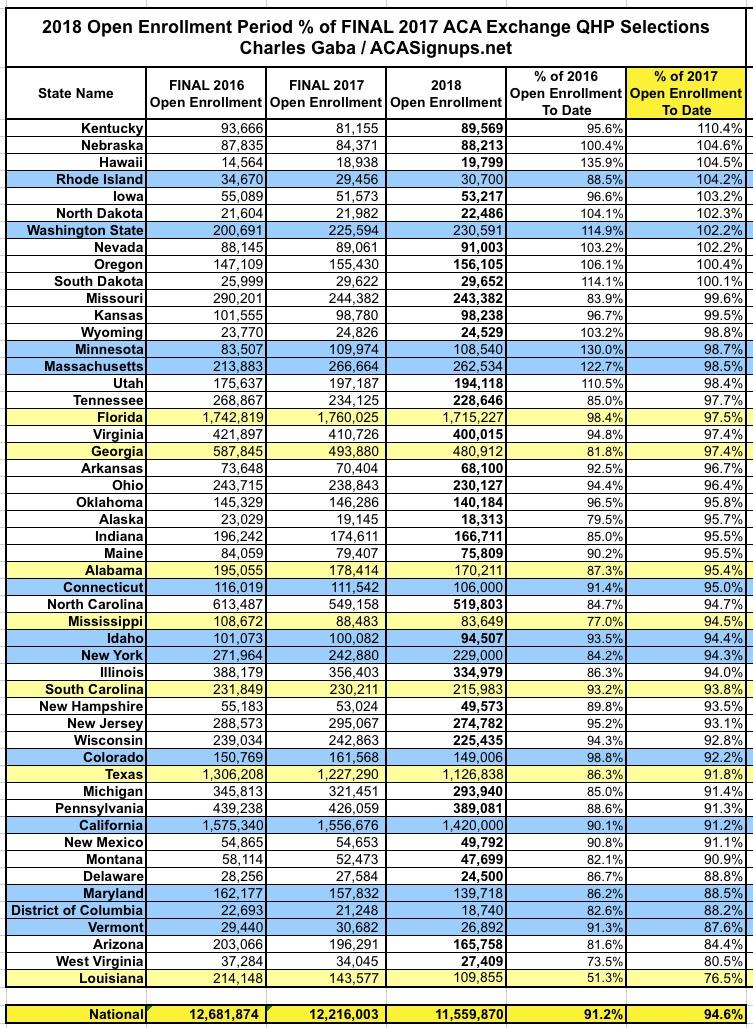UPDATE: Sometimes I hate it when I'm right (even if I had the timing wrong)
Now here's some bad news: The effectuated enrollee drop-off could be fierce this spring, for two important reasons.
...So what's gonna be different for 2018?
Well, first of all, 41 states, the official Open Enrollment deadline was on December 15th. That means that unlike prior years, it's too late for most of these folks to change their minds. They can either stick with the policy they signed up for (or were signed up for) or they can drop it, but that's it. Of course, anyone who was enrolled into a differentpolicy than the one they already had technically still has a 60-day window from 12/31 (until March 1st) to choose a different policy via a Special Enrollment Period, but otherwise their options are limited.
In other words, assuming several hundred thousand people drop their policies after 12/15 but before 1/31, instead of already being accounted for, they won't show up in the until the First Quarter report is released, likely sometime in April. This will make it look as though the "March drop-off" is more like perhaps ~18% instead of ~14%.
The other reason I'm expecting a higher-than-normal attrition rate in Q1 2018 is the FALSE PERCEPTION that the individual mandate has ALREADY been repealed.
...I've already heard anecdotal stories of at least a few people who have already cancelled policies they just enrolled in a week earlier specifically because they falsely think the mandate won't be in effect for 2018.
How many of these cases are there/will there be over the next month? I have no idea, but it's safe to assume it'll add another couple hundred thousand to the "enrolled but cancelled" total. My guess is that assuming there's a formal March 31, 2018 Effectuation Report that is released next spring, it'll probably show a seemingly-shocking plunge of around 20% or so, to perhaps 9.5 million people.
Final Weekly Enrollment Snapshot For 2018 Open Enrollment Period
Approximately 8.7M people selected or were automatically re-enrolled in plans using the HealthCare.gov platform during the 2018 open enrollment period.
These snapshots provide point-in-time estimates of weekly plan selections, call center activity and visits to HealthCare.gov or CuidadoDeSalud.gov. The final snapshot reports new plan selections, active plan renewals and automatic enrollments. It does not report the number of consumers who paid premiums to effectuate their enrollment. This snapshot also does not include plan selections from State-based Exchanges, other than those using the HealthCare.gov platform.
CMS plans to release a more detailed 2018 enrollment report in March, including final plan selection data from State-based Exchanges that do not use the HealthCare.gov platform.
In the end, the final, official net HC.gov QHP selection total actually dropped by 78,687 people between 12/15 and 12/23.
On the one hand, this is exactly what I was warning people to be on the lookout for yesterday. On the other hand, the "purge" of the dropped enrollments was handled earlier than I thought--I had expected them to wait until the Q1 report next spring to subtract these from the total; instead, they've already been removed. I honestly can't fault CMS for doing it this way...regardless of the reasons for people dropping their enrollments, it's actually a "cleaner" enrollment number this way.
I am, however, a bit irritated that they're only providing the net number--it would've been highly useful to know both the gross number of enrollments and the number who then turned around and dropped/were dropped over the past week. For instance, it's possible that, say, 20,000 more signed up but 100,000 dropped...or perhaps 120,000 signed up but 200,000 dropped; either way would give a net drop of around 80,000.
Final sign-ups for Obamacare plans on healthcare.gov reached 8.7 million this open enrollment, falling slightly since last week's deadline partly because some customers canceled plans they were automatically enrolled in.
A week ago, the Centers for Medicare and Medicaid Services reported that 8.8 million people signed up for plans. A CMS official told the Washington Examiner that the number declined because some customers canceled their plans within hours of the deadline, while others canceled plans they were automatically enrolled in.
The final data, which extend to Dec. 23, are difficult to parse because they include added customers who were not tallied as part of the enrollment totals released last week, including those who enrolled between midnight and 3 a.m. on Dec. 16, the final three hours on the West Coast, nor did they include people who had left their numbers with a call center and would still be allowed to enroll. The latest data from Thursday include a mix of these as well as those who dropped out of plans.
...A week after the Dec. 15 deadline for open enrollment, Trump signed a tax code overhaul bill into law that repealed the Obamacare penalties associated with the individual mandate, which required people to buy health insurance or pay a fine. It's not clear whether that had an impact on the drop in enrollment.
It's pretty clear to me that it did have some impact...but again, without having the actual numbers of late enrollments and early cancellations to work with, there's really no way of knowing how much of an impact it's had (or will have going forward).
SEE IMPORTANT UPDATE BELOW!
Anyway, here's the final official state-level numbers; I'll update the graph and spreadsheets momentarily:
Here's how the final state numbers compare against the semi-total from 12/15...as you can see, two states did still end with slightly higher numbers anyway (Alabama and Nevada). Florida had the largest raw drop (understandable since they have the largest enrollment number to begin with), but West Virginia had the highest drop on a percentage basis, losing 2.7% of the prior subtotal.
When I plug the final HC.gov numbers into the master spreadsheet, here's what it looks like...the oddball hurricane SEP additions might nudge it back up a smidge to just barely 11.6 million. If the state-based exchanges are able to tack on another 250K or so by the end of January, the final grand total could end up somewhere around 11.8 million or so.
A little disappointing compared to what things looked like a few days ago, but still pretty damned good considering everything that's been thrown against the ACA the past year.
UPDATE 12/29: D'OH!! Huge shout-out to Tony Sabatino for calling my attention to a so-obvious-it-coulda-bitten-me-on-the-nose data point:
- NEW CONSUMERS (12/15): 2,394,107
- NEW CONSUMERS (12/23): 2,460,431
- RENEWING COVERAGE (12/15): 6,428,222
- RENEWING COVERAGE (12/23): 6,283,211
CMS did include the hard number of additions and subtractions from the 12/15 totals after all! They didn't call attention to it (or break it out by state), but they're there:
- 66,324 additional new enrollees were added between 12/15 - 12/23, however
- 145,011 renewed enrollees dropped their renewals between 12/15 - 12/23
- ...for a net reduction of 78,687...the exact net drop overall.
So there you have it: The "last-minute/callback" enrollees did indeed bump the number up by another 66,000 people (lower than my 100K spitball projection), but 145,000 who had been auto-renewed dropped their coverage over the same period, for a net loss of over 78,000.







